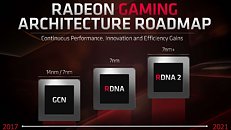- Joined
- Oct 9, 2007
- Messages
- 47,587 (7.45/day)
- Location
- Dublin, Ireland
| System Name | RBMK-1000 |
|---|---|
| Processor | AMD Ryzen 7 5700G |
| Motherboard | Gigabyte B550 AORUS Elite V2 |
| Cooling | DeepCool Gammax L240 V2 |
| Memory | 2x 16GB DDR4-3200 |
| Video Card(s) | Galax RTX 4070 Ti EX |
| Storage | Samsung 990 1TB |
| Display(s) | BenQ 1440p 60 Hz 27-inch |
| Case | Corsair Carbide 100R |
| Audio Device(s) | ASUS SupremeFX S1220A |
| Power Supply | Cooler Master MWE Gold 650W |
| Mouse | ASUS ROG Strix Impact |
| Keyboard | Gamdias Hermes E2 |
| Software | Windows 11 Pro |
Hardware-accelerated ray tracing and variable-rate shading will be the design focal points for AMD's next-generation RDNA2 graphics architecture. Microsoft's reveal of its Xbox Series X console attributed both features to AMD's "next generation RDNA" architecture (which logically happens to be RDNA2). The Xbox Series X uses a semi-custom SoC that features CPU cores based on the "Zen 2" microarchitecture and a GPU based on RDNA2. It's highly likely that the SoC could be fabricated on TSMC's 7 nm EUV node, as the RDNA2 graphics architecture is optimized for that. This would mean an optical shrink of "Zen 2" to 7 nm EUV. Besides the SoC that powers Xbox Series X, AMD is expected to leverage 7 nm EUV for its RDNA2 discrete GPUs and CPU chiplets based on its "Zen 3" microarchitecture in 2020.
Variable-rate shading (VRS) is an API-level feature that lets GPUs conserve resources by shading certain areas of a scene at a lower rate than the other, without perceptible difference to the viewer. Microsoft developed two tiers of VRS for its DirectX 12 API, tier-1 is currently supported by NVIDIA "Turing" and Intel Gen11 architectures, while tier-2 is supported by "Turing." The current RDNA architecture doesn't support either tiers. Hardware-accelerated ray-tracing is the cornerstone of NVIDIA's "Turing" RTX 20-series graphics cards, and AMD is catching up to it. Microsoft already standardized it on the software-side with the DXR (DirectX Raytracing) API. A combination of VRS and dynamic render-resolution will be crucial for next-gen consoles to achieve playability at 4K, and to even boast of being 8K-capable.

View at TechPowerUp Main Site
Variable-rate shading (VRS) is an API-level feature that lets GPUs conserve resources by shading certain areas of a scene at a lower rate than the other, without perceptible difference to the viewer. Microsoft developed two tiers of VRS for its DirectX 12 API, tier-1 is currently supported by NVIDIA "Turing" and Intel Gen11 architectures, while tier-2 is supported by "Turing." The current RDNA architecture doesn't support either tiers. Hardware-accelerated ray-tracing is the cornerstone of NVIDIA's "Turing" RTX 20-series graphics cards, and AMD is catching up to it. Microsoft already standardized it on the software-side with the DXR (DirectX Raytracing) API. A combination of VRS and dynamic render-resolution will be crucial for next-gen consoles to achieve playability at 4K, and to even boast of being 8K-capable.

View at TechPowerUp Main Site









